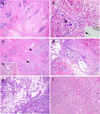Histologic grading of the extent of residual carcinoma following neoadjuvant chemoradiation in pancreatic ductal adenocarcinoma: a predictor for patient outcome
- PMID: 22028089
- PMCID: PMC3269538
- DOI: 10.1002/cncr.26651
Histologic grading of the extent of residual carcinoma following neoadjuvant chemoradiation in pancreatic ductal adenocarcinoma: a predictor for patient outcome
Abstract
Background: Several grading schemes for the extent of residual tumor in posttreatment pancreaticoduodenectomy (PD) specimens have been proposed. However, the prognostic significance of these grading schemes is unknown.
Methods: Histopathologic slides of 223 cases who received neoadjuvant chemoradiation and PD were reviewed. The extent of residual tumor was graded using both the College of American Pathologists (CAP) and the Evans grading systems. The grading results were correlated with clinicopathological parameters and survival.
Results: Among the 223 patients, 6 patients (2.7%) showed pathologic complete response (pCR; CAP grade 0 or Evans grade IV), 36 cases (16.1%) had minimal residual tumor (CAP grade 1 or Evans grade III), 124 cases (55.6%) had moderate response (CAP grade 2 or Evans grade IIb), and 57 cases (25.6%) had poor response (CAP grade 3, where 18 had Evans grade I and 39 had Evans grade IIa response). Patients with pCR or minimal residual tumor (response group 1) had better survival rates than those with moderate and poor response (response group 2). Response group 1 patients had lower posttherapy tumor and American Joint Committee on Cancer stages and lower rates of lymph node metastasis, positive resection margin, and recurrence and/or metastasis. Grading the extent of residual tumor is an independent prognostic factor for overall survival in multivariate analysis.
Conclusions: pCR or minimal residual tumor in posttreatment PD specimens correlate with better survival in patients with pancreatic ductal adenocarcinoma who received neoadjuvant therapy and PD. Histologic grading of the extent of residual tumor in PD specimen is an important prognostic factor in patients with pancreatic ductal adenocarcinoma who received neoadjuvant therapies.
Copyright © 2011 American Cancer Society.
Figures



Similar articles
-
Comparison of Tumor Regression Grading of Residual Pancreatic Ductal Adenocarcinoma Following Neoadjuvant Chemotherapy Without Radiation: Would Fewer Tier-Stratification Be Favorable Toward Standardization?Am J Surg Pathol. 2019 Mar;43(3):334-340. doi: 10.1097/PAS.0000000000001152. Am J Surg Pathol. 2019. PMID: 30211728
-
Validation of a Proposed Tumor Regression Grading Scheme for Pancreatic Ductal Adenocarcinoma After Neoadjuvant Therapy as a Prognostic Indicator for Survival.Am J Surg Pathol. 2016 Dec;40(12):1653-1660. doi: 10.1097/PAS.0000000000000738. Am J Surg Pathol. 2016. PMID: 27631521 Free PMC article.
-
Superior Mesenteric Artery Margin of Posttherapy Pancreaticoduodenectomy and Prognosis in Patients With Pancreatic Ductal Adenocarcinoma.Am J Surg Pathol. 2015 Oct;39(10):1395-403. doi: 10.1097/PAS.0000000000000491. Am J Surg Pathol. 2015. PMID: 26200098
-
Critical issues in pathologic evaluation of pancreatic ductal adenocarcinoma resected after neoadjuvant treatment: a narrative review.Chin Clin Oncol. 2022 Jun;11(3):21. doi: 10.21037/cco-21-175. Epub 2022 Jun 16. Chin Clin Oncol. 2022. PMID: 35726190 Free PMC article. Review.
-
A single center experience in resectable pancreatic ductal adenocarcinoma : the limitations of the surgery-first approach. Critical review of the literature and proposals for practice update.Acta Gastroenterol Belg. 2017 Oct-Dec;80(4):451-461. Acta Gastroenterol Belg. 2017. Retraction in: Acta Gastroenterol Belg. 2018 Apr-Jun;81(2):358. PMID: 29560639 Retracted. Review.
Cited by
-
Impact of histological response after neoadjuvant therapy on podocalyxin as a prognostic marker in pancreatic cancer.Sci Rep. 2021 May 10;11(1):9896. doi: 10.1038/s41598-021-89134-2. Sci Rep. 2021. PMID: 33972616 Free PMC article.
-
Recurrence Patterns for Pancreatic Ductal Adenocarcinoma after Upfront Resection Versus Resection Following Neoadjuvant Therapy: A Comprehensive Meta-Analysis.J Clin Med. 2020 Jul 6;9(7):2132. doi: 10.3390/jcm9072132. J Clin Med. 2020. PMID: 32640720 Free PMC article.
-
Preoperative Modified FOLFIRINOX Treatment Followed by Capecitabine-Based Chemoradiation for Borderline Resectable Pancreatic Cancer: Alliance for Clinical Trials in Oncology Trial A021101.JAMA Surg. 2016 Aug 17;151(8):e161137. doi: 10.1001/jamasurg.2016.1137. Epub 2016 Aug 17. JAMA Surg. 2016. PMID: 27275632 Free PMC article. Clinical Trial.
-
Predicting Pathological Response to Preoperative Chemotherapy in Pancreatic Ductal Adenocarcinoma Using Post-Chemotherapy Computed Tomography Radiomics.Cureus. 2024 Jan 13;16(1):e52193. doi: 10.7759/cureus.52193. eCollection 2024 Jan. Cureus. 2024. PMID: 38348011 Free PMC article.
-
Proposal for a New Pathologic Prognostic Index After Neoadjuvant Chemotherapy in Pancreatic Ductal Adenocarcinoma (PINC).Ann Surg Oncol. 2022 Jun;29(6):3492-3502. doi: 10.1245/s10434-022-11413-7. Epub 2022 Mar 1. Ann Surg Oncol. 2022. PMID: 35230580 Free PMC article.
References
-
- Jemal A, Siegel R, Xu J, Ward E. Cancer statistics, 2010. CA Cancer J Clin. 60(5):277–300. - PubMed
-
- Huguet F, Orthuon A, Touboul E, Marseguerra R, Mornex F. Pancreatic cancer. Cancer Radiother. 2010;14(Suppl 1):S94–S102. - PubMed
-
- Garcea G, Dennison AR, Pattenden CJ, Neal CP, Sutton CD, Berry DP. Survival following curative resection for pancreatic ductal adenocarcinoma. A systematic review of the literature. JOP. 2008;9(2):99–132. - PubMed
-
- Ishikawa O, Ohhigashi H, Sasaki Y, Imaoka S, Iwanaga T, Teshima T, et al. The histopathological effect of preoperative irradiation in adenocarcinoma of the periampullary region. Nippon Gan Chiryo Gakkai Shi. 1988;23(3):720–727. - PubMed
-
- Evans DB, Rich TA, Byrd DR, Cleary KR, Connelly JH, Levin B, et al. Preoperative chemoradiation and pancreaticoduodenectomy for adenocarcinoma of the pancreas. Arch Surg. 1992;127(11):1335–1339. - PubMed
Publication types
MeSH terms
Grants and funding
LinkOut - more resources
Full Text Sources
Medical
Miscellaneous

